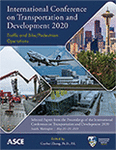International Conference on Transportation and Development 2020
A Rule Based Control Algorithm for On-Ramp Merge with Connected and Automated Vehicles
Publication: International Conference on Transportation and Development 2020
ABSTRACT
One of the designs for future highways with mixed flow of connected automated vehicles (CAVs) and manual cars will be a dedicated lane for the CAVs to form platoons and travel with higher speeds and lower headways. Connectivity between vehicles and the infrastructure will enable control strategies to become more advanced. The connectivity will enable the formation of platoons of CAVs which will travel beside non-platoon lanes. Every connected vehicle joining the highway from an onramp will have the challenge of when and where—while traveling on the acceleration lane—to join the adjacent mainline of the highway. In this research, the aim is developing a model for investigating the effects of different merge actions yielding a more efficient and systematic method for the vehicles joining the mainlines comprised of platoon and non-platoon lanes. The actions tested for assisting the merge process include deceleration in the mainlines, joining a platoon, etc. The model targets to direct every CAV entering a multi-lane highway segment from an on-ramp, to the rightmost lane of the highway based on the appropriate action which is selected according to the traffic conditions on the mainline. To account for car following behavior, the platoon lanes are assumed to have a simplified CACC (cooperative adaptive cruise control) and the non-platoon lanes the IDM+ car-following model. Numerous simulation experiments proved the efficiency of the model in increasing the throughput in the merge area. The results of this research will help in the design and development of advances systems for controlling on-ramp merge sections in the future with CAVs.
Get full access to this article
View all available purchase options and get full access to this chapter.
REFERENCES
Ahmed, M. S., Hoque, M. A., Rios-Torres, J., & Khattak, A. J. (2018). A Cooperative Freeway Merge Assistance System using Connected Vehicles. CoRR, abs/1805.00508.
Bevly, D., Cao, X., Gordon, M., Ozbilgin, G., Kari, D., Nelson, B., … Ozguner, U. (2016). Lane Change and Merge Maneuvers for Connected and Automated Vehicles: A Survey. IEEE Transactions on Intelligent Vehicles, 1(1), 105-120. doi: https://doi.org/10.1109/TIV.2015.2503342.
Board, T. R., National Academies of Sciences, E., & Medicine. (2017). Strategies to Advance Automated and Connected Vehicles. Washington, DC: The National Academies Press.
Clements, L. M., & Kockelman, K. M. (2017). Economic Effects of Automated Vehicles. Transportation Research Record, 2606(1), 106-114. doi: https://doi.org/10.3141/2606-14.
Fagnant, D. J., & Kockelman, K. (2015). Preparing a nation for autonomous vehicles: opportunities, barriers and policy recommendations. Transportation Research Part A: Policy and Practice, 77, 167-181. doi: https://doi.org/10.1016/j.tra.2015.04.003.
Fernandes, P., & Nunes, U. (2015). Multiplatooning Leaders Positioning and Cooperative Behavior Algorithms of Communicant Automated Vehicles for High Traffic Capacity. IEEE Transactions on Intelligent Transportation Systems, 16(3), 1172-1187. doi: https://doi.org/10.1109/TITS.2014.2352858.
Handbook, F. H. A. FHWA HANDBOOK.
Jones, S. (2013). Cooperative Adaptive Cruise Control: Human Factors Analysis.
Kamali, M., Dennis, L. A., McAree, O., Fisher, M., & Veres, S. M. (2017). Formal verification of autonomous vehicle platooning. Science of Computer Programming, 148, 88-106. doi: https://doi.org/10.1016/j.scico.2017.05.006.
Karbalaieali, S., Osman, O. A., & Ishak, S. (2018). Evaluation of a Novel Model for Cooperative Merging of Connected Automated Vehicles onto Automated Highways. Paper presented at the Transportation Research Board 97th Annual Meeting, Washington DC, United States.
Lioris, J., Pedarsani, R., Tascikaraoglu, F. Y., & Varaiya, P. (2017). Platoons of connected vehicles can double throughput in urban roads. Transportation Research Part C: Emerging Technologies, 77, 292-305. doi: https://doi.org/10.1016/j.trc.2017.01.023.
Michaud, F., Lepage, P., Frenette, P., Letourneau, D., & Gaubert, N. (2006). Coordinated Maneuvering of Automated Vehicles in Platoons. IEEE Transactions on Intelligent Transportation Systems, 7(4), 437-447. doi: https://doi.org/10.1109/TITS.2006.883939.
Nowakowski, C., O’Connell, J., Shladover, S., & Cody, D. (2010). Cooperative Adaptive Cruise Control: Driver Acceptance of Following Gap Settings Less than One Second (Vol. 3).
Rahman, M., Chowdhury, M., Dey, K., Islam, M. R., & Khan, T. (2017). Evaluation of Driver Car-Following Behavior Models for Cooperative Adaptive Cruise Control Systems. Transportation Research Record: Journal of the Transportation Research Board, 2622, 84-95. doi: https://doi.org/10.3141/2622-08.
Rios-Torres, J., & Malikopoulos, A. A. (2017). Automated and Cooperative Vehicle Merging at Highway On-Ramps. IEEE Transactions on Intelligent Transportation Systems, 18(4), 780-789. doi: https://doi.org/10.1109/TITS.2016.2587582.
Subraveti, H. H. S. N., Knoop, V. L., & Arem, B. v. (2018). Rule based control for merges: Assessment and case study. 2018 21st International Conference on Intelligent Transportation Systems (ITSC), 3006-3013.
Talebpour, A., & Mahmassani, H. S. (2016). Influence of connected and autonomous vehicles on traffic flow stability and throughput. Transportation Research Part C: Emerging Technologies, 71, 143-163. doi: https://doi.org/10.1016/j.trc.2016.07.007.
Tiernan, T. A., Richardson, N., Azeredo, P., Najm, W. G., & Lochrane, T. (2017). Test and Evaluation of Vehicle Platooning Proof-Of-Concept Based on Cooperative Adaptive Cruise Control.
Treiber, Hennecke, & Helbing. (2000). Congested traffic states in empirical observations and microscopic simulations. Physical review. E, Statistical physics, plasmas, fluids, and related interdisciplinary topics, 62 2 Pt A, 1805-1824.
Varaiya, P. (1993). Smart cars on smart roads: problems of control. IEEE Transactions on Automatic Control, 38(2), 195-207. doi: 10.1109/9.250509.
Journal of Intelligent Transportation Systems, 21(2), 136-147. doi: 10.1080/15472450.2016.1248288.
Information & Authors
Information
Published In
International Conference on Transportation and Development 2020
Pages: 303 - 316
Editor: Guohui Zhang, Ph.D., University of Hawaii
ISBN (Online): 978-0-7844-8315-2
Copyright
© 2020 American Society of Civil Engineers.
History
Published online: Aug 31, 2020
Published in print: Aug 31, 2020
Authors
Metrics & Citations
Metrics
Citations
Download citation
If you have the appropriate software installed, you can download article citation data to the citation manager of your choice. Simply select your manager software from the list below and click Download.
